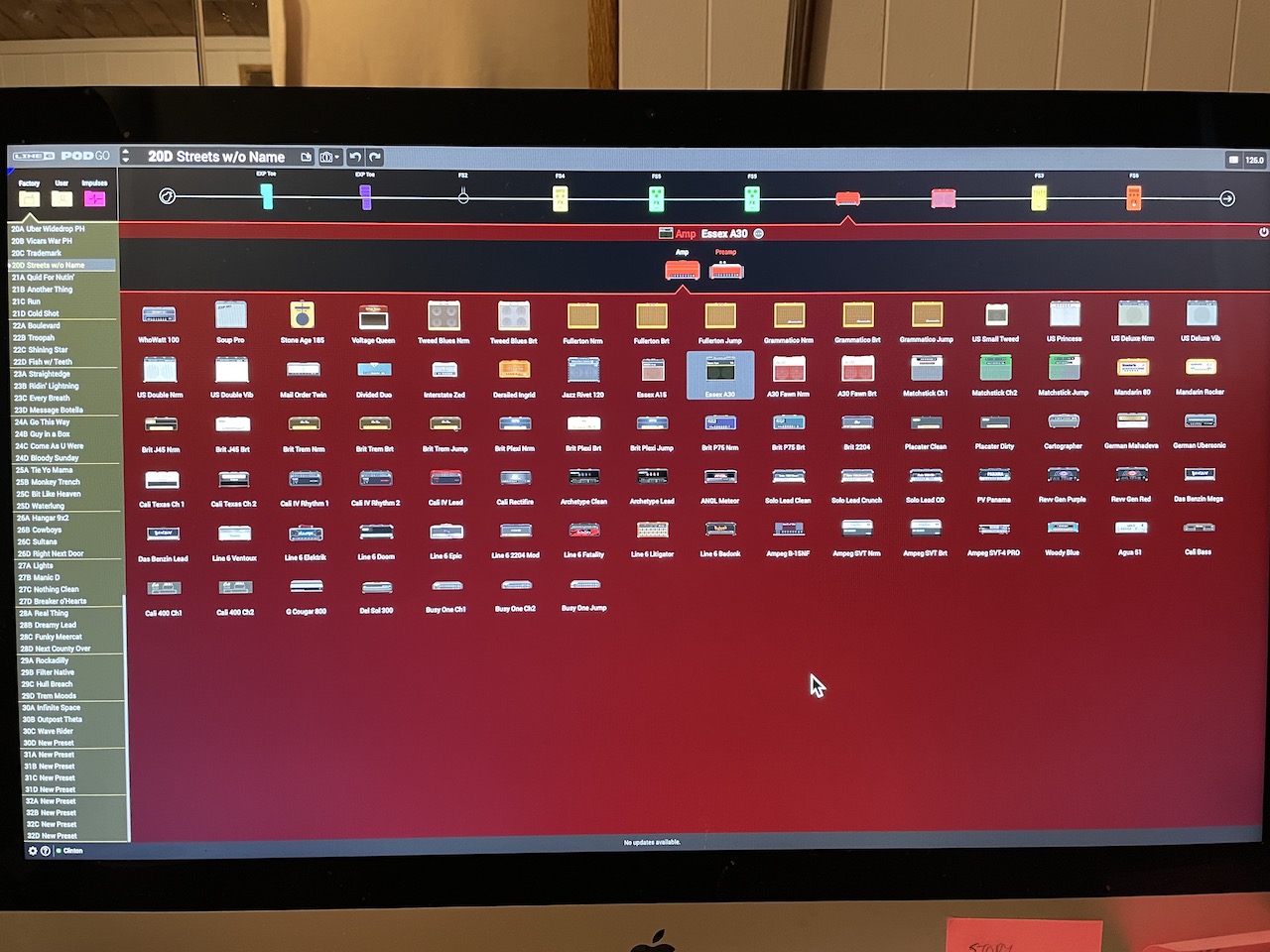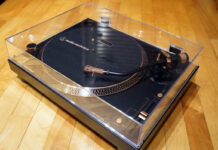 The Line 6 POD Go guitar processor is an all-in-one guitar multi-FX processing unit that is a very compelling tool for stage, studio, and rehearsal. I tested it during the past few days so let’s take a look at the unit and its many features. I will offer several details on the sound and its capabilities, and I will give you my opinion on the Line 6 POD Go to help you better understand what the POD Go can bring to your guitar-playing experience. Let’s dive in.
The Line 6 POD Go guitar processor is an all-in-one guitar multi-FX processing unit that is a very compelling tool for stage, studio, and rehearsal. I tested it during the past few days so let’s take a look at the unit and its many features. I will offer several details on the sound and its capabilities, and I will give you my opinion on the Line 6 POD Go to help you better understand what the POD Go can bring to your guitar-playing experience. Let’s dive in.
The Line 6 POD Go is loaded with features
The Line 6 POD Go features everything you need for an electric guitar—and plenty of it. The unit covers a lot of ground and can be as simple or complex as you want or need it to be. If you are a casual or a professional guitarist, you will enjoy its many features.
Here is a brief rundown of its features:
- 270 (or more!) HX and legacy amp models
- Effects models for every major guitar effect imaginable
- Cast Aluminium expression pedal (volume or wah), with the capacity to add another
- A large colour LCD screen to help manage presets and effects
- Five push-button “encoders” for editing the parameters of each individual effect/amp/model
- Eight sturdy footswitches
- Compact and lightweight design
- Many output options, which include balanced stereo, split signal (before any cabinet modelling), stereo effects loop, headphone jack, and a USB connection for connection to your DAW
- A looper function, with four different types of looping available
- Snapshot mode that allows easy access to all tones needed for different sections of different songs
- POD Go Edit app (which is free) for editing your presets from your computer
Note that any time I write a review of a guitar processor as diverse as the Line 6 POD Go, I make sure to start by reading the owner’s manual. The POD Go’s manual is indispensable. Whether as an owner or a prospective buyer, it explains in great depth the many features of this guitar effect unit. It is well worth your time if you want to get the most out of the guitar processor or to decide if it could be the right unit for you.
The POD Go’s layout is simple, yet thorough
The front panel of the Line 6 POD Go has everything you need at your fingertips. It provides everything you need to build presets, manipulate them during live performances, and switch quickly between various snapshots you create. Let’s take a closer look.

The colour LCD screen is a great touch
I quickly developed a relationship with the colour LCD screen. The screen is big, but not enormous. It seems quite ample for my needs!
The colour-coding of the various presets helps create a quick flow, as they are linked to the presets and to the stomp knobs as well. When playing live, it is reassuring to know that, instead of looking at the details of your preset, you can simply reach for the colour of the effect you need.
Eight stomp buttons (six are for effects)
The stomp buttons on the POD Go serve different purposes depending on the mode used. You can use the stomp buttons for jumping between presets, switching on/off stomp effects, activating the looper function or jumping between snapshots.
The buttons are high quality and are backlit to match the colour coding of the various effects, which are clearly visible on the colour LCD screen. It is a simple and effective design using primary colours, which is extra helpful for colour-blind people like me!
One of the stomp buttons is for switching from preset mode to stomp mode. Another of the knobs is for a tuner mode, which is indispensable.
Five push-button “encoders” for tweaking parameters
All parameters are highly customisable on the POD Go. Most adjustments can be done quickly via the five push-button knobs that align with the colour screen. In most cases, you simply need to turn the button to alter your parameter, then push it to lock it in or save it.
“Home” and “Page” are great for scrolling presets quickly and changing settings
The Home and Page sections are a macro view into the many features of this guitar processor. Each has a different function, which can vary depending on the moment. The Home section seems to be most useful when scrolling quickly amongst the hundreds of presets, and the Page section is probably most useful when a preset has multiple (more than five) parameters to manipulate.
Volume/Expression pedal
The Volume/Expression pedal is made of cast aluminium and is super solid. What I really like about this pedal is that it can switch easily from expression mode to volume mode. When you ride the pedal all the way to the top (actually, beyond the top) it switches functions. To avoid any confusion, there are two small lights marked WAH and VOL which indicate which mode the unit is currently using. It is a small but important detail, kudos for including it!
The rear output panel shows many options for performing and recording

The rear panel of the Line 6 POD Go demonstrates the choices possible for live, direct, and studio situations. Here, there is a headphone output (PHONES), AMP OUT (should you wish to send to your own amp on stage), MAIN OUT L/R (for sending to a mixer console or powered speaker), FX LOOP (send and return—for using your own outboard effects), and an EXP 2 Footswitch (for using a 2nd expression pedal). The sole input is the GUITAR INPUT.
The input and all outputs are standard ¼”, including the headphone output.
USB connection turns the POD Go into a recording interface
The final output on the back panel is a USB connection. Interfacing the guitar processor with your computer allows for easy recording options through your DAW. Here, there is an interesting feature. Line 6 has engineered the interface to split and send both processed and clean guitar signals to the DAW simultaneously.
The split signal is a valuable feature because you can record the presets that you want for any particular song, and you can record a second “clean” DI signal that can be used for many purposes later on. This is perfect for anyone who uses the re-amping process that is so common in today’s music productions.
The MAIN OUT outputs on the interface can also send audio to powered studio monitors.
The recording interface might not be an obvious use of the POD GO. However, I find it quite intriguing and useful.
Professional quality amp, cab and effect modelling
The Line 6 PRO Go features a multitude of amp/power amp models to choose from. The user’s manual lists 86 different settings. Some amp models repeat themselves, providing different channels for each amp. For example, the “Brit Trem” model has three different versions: “Nrm”, “Brt” and “Jump” (“Normal”, “Bright” and “Jumped”).
Overall, the Line 6 PRO Go contains at least one of every amp imaginable. Each model is not directly named in the unit itself (my best guess is this is for copyright reasons), but a look at the user’s manual provides a detailed description of each.
The quality of the amp models is simply amazing. As I scroll through the basic presets, there is no doubt about the type of amp being used. There is no doubt which kind of amp is being modelled, the character shines through.
All settings are highly adjustable and customisable as well, either directly on the unit or via the Line 6 POD Go EDIT app.
Matching cabinets are automatically assigned but also interchangeable
There are at least 41 speaker cabinet models to choose from. The array is astonishing and complete. When you select an amp model, the cabinet is automatically matched. This is an efficient and smart setup which puts us even more into the analogue world of guitar amps. More experienced users might prefer a custom setup, and the POD Go guitar processor allows for mixing and matching different amp and cabinet models as well. The combinations seem to be limitless!
The Line 6 POD Go has TONS of effects
The Line 6 POD Go is loaded with effects options. Everything seems to be available, including many of the original Line 6 classics that the brand is known for. There are literally dozens to choose from in all the requisite categories: Distortion, Dynamic, EQ, Modulation, Delay, Reverb, Pitch, and Filter.
As with the amp models, each effect is highly customisable. Once again, the sky is the limit for dialling in new and classic guitar sounds.
“Semi-fixed” serial signal path helps you create patches
The Line 6 Pod Go assists you when building custom patches. Instead of using a wide-open approach, Line 6 proposes a basic template chain of effects/models for constructing patches. This is immediately useful, avoiding “faux pas” concepts that would not be viable in the strictly analogue world. As a beginner, it would teach you a lot about the effects process. As a professional, it would help you avoid oversight when building your rig.
Preset, Stomp, and Snapshot modes for all playing situations
It makes sense to approach the Pod Go guitar processor via three modes: Preset, Stomp, and Snapshot.
The Preset mode is the most universally accessible, allowing you to use the many Line 6 presets or your own custom presets. There is a scroll menu using the left two stomp buttons (up/down) on the Pod Go. It’s convenient for preset shopping, and you could even organise your presets in performance order, which I suggest would be easiest to do via the POD Go EDIT app.
However, you can also enter into Stomp mode via the MODE stomp button on the top right side of the POD Go. Here, you have 6 stomp buttons available to turn on/off various effects while playing live. For some guitarists, this feels like the classic approach, and nothing feels better than hitting that pedal to launch into a heavy distortion exactly when you need it.
If you have multiple stomps to make at any given moment, the POD Go guitar processor contains an option to help. The Snapshots feature allows you to create 4 different “snapshots” of any patch. Think of it as a patch within a patch, with up to four variations. Using this feature, multiple parameters can be changed with one stomp, so long as you are within the existing chain.
For live performance, using Snapshots opens up the whole POD Go system in a big way. It takes a little bit of learning to set up, but the potential is enormous for guitarists involved with many projects calling for intricate details.
Multiple looper functions, from simple to complex
Full disclosure here. I am not the most experienced looper user. After some time spent getting used to the function, I see it is tremendously versatile! Depending on the choice of mode, anywhere between 20 and 80 seconds of looping are available. Options range from simple to detailed, from 1 switch to 6 switches. You can also place the loop anywhere you want in your effects chain, which is a fantastic creative tool.
Line 6 POG Go EDIT App makes editing and setup easy

With so many features available, Line 6 offers the POD Go EDIT app free of charge to help you with your workflow. The app connects you to everything you can do inside the physical unit, controlling it from your computer via USB connection. It is a simple and deep app that adds a lot of value to the overall POD Go user experience. I like it because it provides more of a bird’s eye view of how things are organized.
A top-notch guitar processor worth the investment
To conclude my review, I will say that I am extremely impressed with the Line 6 POD Go guitar processor. Its many features and flexible range of use make it a one-stop purchase for hobby and professional guitarists alike. It is portable, rugged, full of options, and most importantly, it sounds amazing.
At this price range, there is no second-guessing its value. Once comfortable with the unit, you will be set for a long while to come. Which of the POD Go’s features intrigue you the most? Let me know in the comments section below.
You can find the Line 6 POD Go multi-effects guitar processor at Best Buy.



